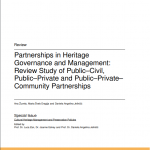
Journal: Journal of Risk and Financial Management, Vol. 14, no. 10
Publisher: MDPI
Year: 2021
ISSN 1911-8074
Abstract:
Cultural heritage has, for a long time, been considered a source of wealth and well-being for economies. Currently, considerable investments have been allocated for its renewal and maintenance that often surpass the budgets of owners, local communities, and other interested users. Cultural heritage valorisation is expensive and is a great economic challenge. Infrastructural investment, i.e., conservation and restoration, are just one part of the total costs of cultural heritage preservation, while other investments relate to regular operation and maintenance. One of the most difficult decisions for those who design the cultural heritage restoration projects is how to finance them, i.e., what the most efficient financial instruments are for renewal of cultural heritage. These assumptions have instigated interest in the evaluation of services resulting from common good functions of cultural heritage, such as economic, educational, historical, technological, ecological, and climate, as well as tourism and recreational. Therefore, this article starts from the analysis of potential funding sources for cultural heritage through the European Union (EU) funds; a method of economic evaluation of the return on investments and cost–benefit analysis is suggested as a method that should be used in decision making on these interventions.
Keywords: cultural heritage; cultural heritage projects; EU funds; economic analysis; cost–benefit analysis
LINK:
The article is acessible at https://www.mdpi.com/1911-8074/14/10/466.




